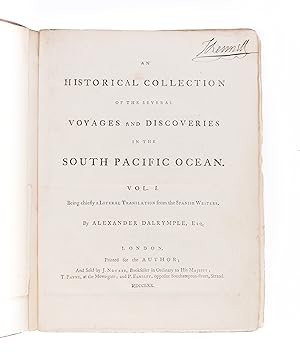Historical Collection Several Voyages Discoveries South Pacific Ocean, First Edition (1 results)
Product Type
- All Product Types
- Books (1)
- Magazines & Periodicals
- Comics
- Sheet Music
- Art, Prints & Posters
- Photographs
- Maps
-
Manuscripts &
Paper Collectibles
Condition
- All Conditions
- New
- Used
Binding
- All Bindings
- Hardcover
- Softcover
Collectible Attributes
- First Edition
- Signed
- Dust Jacket
- Seller-Supplied Images
- Not Printed On Demand
Seller Location
Seller Rating
-
An Historical Collection of the Several Voyages and Discoveries in the South Pacific Ocean
Publication Date: 1771
Seller: Maggs Bros. Ltd ABA, ILAB, PBFA, BA, London, United Kingdom
First Edition
Vol. I. Being chiefly a Literal Translation from the Spanish Writers. [Volume II. Containing the Dutch Voyages.] First edition (second issue of Vol. I as usual). 2 vols. in 1. 4 folding maps & 12 plates (mostly folding). 4to. Contemporary calf, rebacked. xxx, [2], 24, 24, 204, [4]; [iv], 124, 20, [58]pp. London, 1770 & An excellent copy connecting two important eighteenth century cartographers. With the neat ownership signature of the noted cartographer James Rennell (1742-1830) to the upper margin of the title page, and his book plate on the front pastedown. James Rennell was a close colleague of Dalrymple's, accompanying him on his second voyage on the London, to Sulu, Balambangan and further afield to China 1759-62. There Rennell served as assistant draughtsman or surveyor. They obviously had a great deal in common and their relationship endured. He became one of a ?close-knit group which included Philip Stephens, Evan Nepean, . and William Marsden? who assisted Dalrymple when he provided plans and charts for Vancouver's voyage, ?advised the Colonial Office on routes to supply Nootka Sound after the Spanish controversy in 1790, furnished sailing directions to Cathcart's abortive embassy to China in 1788, advised Banks on the privy council examination of Meares, and advised on ports of refuge in South America for the southern whale fishery? (ODNB). The Historical Collection is a work of far reaching importance; its author was the leading English hydrographer of his day, a man of great dedication and prolific output. Passionately involved in the argument over the possible existence of a southern continent, Dalrymple partially translates here some twelve accounts which support his belief in its existence. Dalrymple had wanted command of the official South Seas Expedition sent in 1768. He was much aggrieved not to have been given the appointment, feeling that his preeminence as a hydrographical scholar should have outweighed his relative inexperience of nautical command. Understandably the Admiralty thought otherwise, and Lieut. James Cook was given his chance. A much embittered man, Dalrymple immersed himself in the research which finally led to the publication of this book, which was issued before the return of Cook's expedition. Hill, p.389; Sabin, 18338; Hocken, p7.


